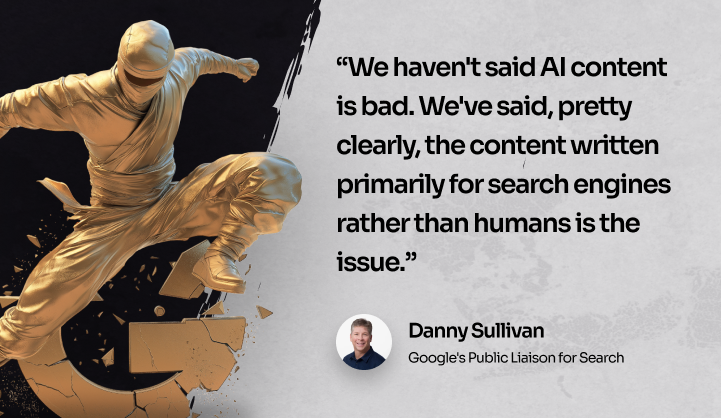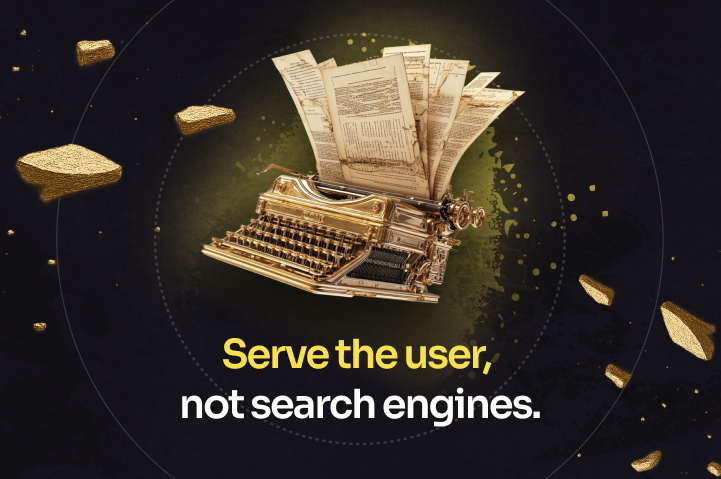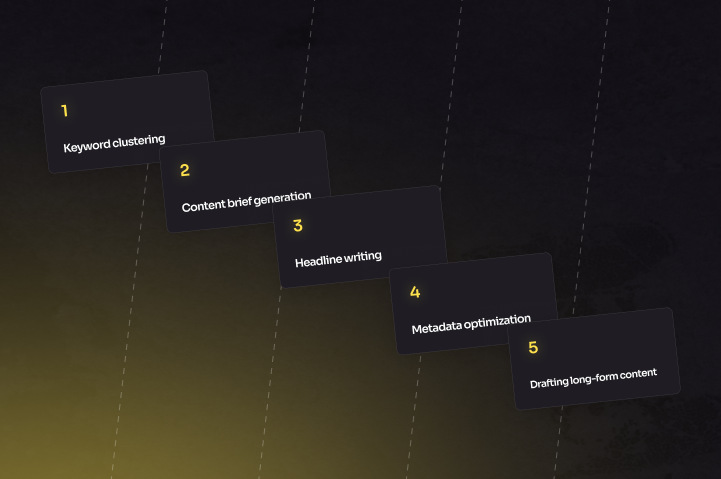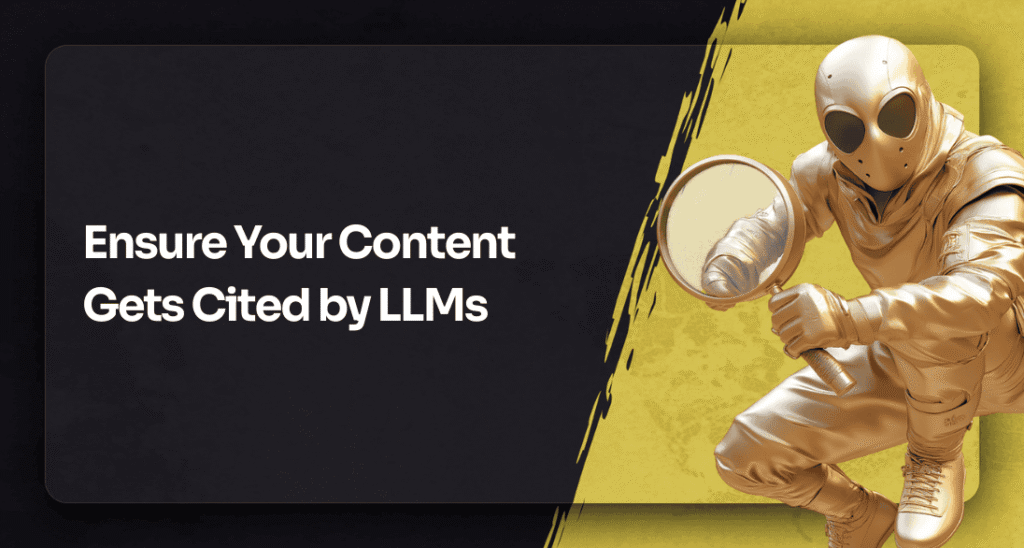The short answer?
It depends. Same as everything else in SEO.
AI speeds up content creation while also raising ethical issues that can affect SEO performance. We’re not talking about fluff content or keyword spam; we’re talking about intent.
Are you using AI to add real value? Or are you gaming the system with SEO tactics that chase volume over substance?
Google doesn’t hate AI-generated content. It hates bad content. Period. And if your strategy is “pump out 500 blogs a month with zero depth, content king,” you’re not scaling; you’re sprinting toward irrelevance.
With AI disclosure rules looming, authorship guidelines tightening, and search algorithms getting smarter at sniffing out manipulation, that “shortcut” you’re banking on might be the reason your visibility tanks.
Bottom line: AI isn’t a cheat code. It’s a tool. Smart use drives rankings. Lazy use kills them.
AI Content Tools: Where It Started, and How We Got Here
Early AI tools relied on rule-based Mad Libs-style systems and templates programmed to follow predefined logic. They could produce formulaic content suitable for specific tasks, like weather reports or financial summaries.
Although efficient, they were rigid and lacked contextual understanding.
The introduction of transformer-based models, particularly OpenAI’s GPT series, marked a significant leap since they were built on enormous corpora of online data, enabling them to mimic human language and generate SEO-driven content.
These models utilize attention mechanisms to understand the relationships between words in a sentence and the meaning behind them.
How They Work
Behind every polished AI-generated paragraph is a powerful tech stack. But strip away the jargon, and it comes down to two core engines:
- Machine Learning
- Natural Language Processing (NLP)
In other words, behind a single click is a full-blown technical engine.
1. Massive data in, pattern recognition out
AI tools like ChatGPT are trained on complex data sets of the existing content sourced from the whole internet. We're talking trillions of words processed through advanced machine learning algorithms.
The goal?
To teach the model how humans write, speak, argue, explain, summarize, and persuade.
Artificial intelligence doesn’t memorize content.
It learns patterns and uses probability to predict what should come next in a sequence of words.
2. NLP is how AI mimics human language
Natural Language Processing (NLP) is the subfield of AI that helps machines understand and generate human language.
Modern NLP models rely on the capabilities of the underlying AI model which can:
- Understand context
- Determine the prevailing emotional opinion
- Identify entities (names, dates, locations)
- Handle diverse languages
- Generate human-like responses
- Adjust tone, complexity, and format
3. Generative AI learns from feedback
Some advanced tools (especially enterprise-level systems) allow for reinforcement learning from human feedback (RLHF).
That means:
- You rate the outputs
- The system learns what “good” looks like
- Future outputs align more with your preferences
That’s how ChatGPT improved from clunky responses in 2021 to nuanced writing in 2024.
Google’s Take on AI-Generated Content

Despite the noise, Google’s stance is simple.
As Danny Sullivan, their Public Liaison for Search, puts it: “We haven't said AI content is bad. We've said, pretty clearly, the content written primarily for search engines rather than humans is the issue. That's what we're focused on. If someone fires up 100 humans to write content just to rank, or fires up a spinner, or an AI, same issue...”
It’s not the tool that gets you buried in search engine results. It’s what you do with it. The real issue? Intent.
If you’re churning out low-value fluff to game the algorithm, that’s what crosses the line, not the tool you used to write it.
Google has always been laser-focused on providing value to the reader. Its systems blend machine learning + human review to sift out the junk and reward high quality content that actually helps people.
Want to know what they stand for? You’ll find the answers in two key sources:
Both hammer home the same message:
- Write for people first.
- Be relevant, be useful, and be honest.
And yes, E-E-A-T (Experience, Expertise, Authoritativeness, Trust) still runs the show. It doesn’t matter if it’s AI-generated or human-crafted content. If you’re touching YMYL (Your Money or Your Life) topics, you better bring real accuracy and visible oversight.
Let’s not dance around it: AI can support great content, but it doesn’t excuse bad content. The standard hasn’t changed - help the user or get out of the way.
Google’s Priority: Quality, Not Origin
Google doesn’t care if a human, an AI, or a hyper-intelligent squirrel wrote your content. What it does care about is quality, intent, and whether your content raises quality concerns that could erode trust.
Google has made it clear in the SQRG:
Relevance. Accuracy. Usefulness.
Not origin.
While E-E-A-T isn’t a direct ranking factor, it’s the framework Google uses to train the humans who shape its algorithms. So yes, it matters.
But Google isn’t just updating blog posts. It’s rewriting the rules of the web. Recent spam updates (Oct 2022, Dec 2022, and March 2024) show a zero-tolerance stance toward sites that automatically apply templated outputs from content generation tools without human oversight.
Here’s what will get you penalized:
- Scaled content abuse
Churning out hundreds of pages with no original insight?
Whether written by a content writer or ChatGPT, Google flags it.
Volume alone ≠ value.
- Auto-generated fluff
AI-generated content is fine if it’s reviewed, enhanced, and offers real substance. Yeah, Google’s not having it. If you’re optimizing for clicks instead of credibility, expect to lose both.
- Site reputation abuse (a.k.a. parasite SEO)
Hosting low-quality, third-party content on your domain to game authority? That now qualifies as explicit spam. Google is cracking down on “rent-a-domain” schemes.
- Expired domain abuse
Buying up an aged domain to push low-effort content? That loophole’s closed. Google shut it down in March 2024.
- Misleading or hidden sponsorships
Google is also pushing harder for transparency in sponsored content. If you pay for content, disclose it. No sneaky links. No cloaked intent.
- Manipulative link schemes
Buying backlinks, stuffing anchor text, or propping up your site with shady networks? Google sees right through it.
So What Does Google Want?

Simple.
Content that:
- Answers real questions
- Shows evidence of expertise
- Demonstrates original thinking or first-hand experience
- Is accurate, up-to-date, and authored
In other words: serve the user, not search engines.
Is AI-Generated Content Deceptive? Here’s the Real Question
We’re drowning in content. Some of it drives real value. Most of it? Not so much. In this cluttered landscape, transparency isn’t a nice-to-have; it’s a credibility signal.
As AI-generated content floods the internet, Google’s scrutiny will only sharpen. If you’re scaling content with AI, hiding it isn’t smart. It’s risky.
There’s no legal rule (yet) that says you must disclose AI use. But some platforms already are.
Phrases like "This article was generated using AI tools and edited by our editorial team” are popping up more often. Not to downplay the work, but to protect trust.
And while Google hasn’t drawn a hard line, its guidance is clear enough:
Be transparent where appropriate.
Because here’s the kicker:
- Most readers still assume the content is human-made.
- What if they find out otherwise after spotting errors or fluff? That trust is gone.
Who is winning trust?
Those who say, “Yes, we use AI, and here’s how we ensure our content is reliable and helpful.”
Tools like Jasper can help brainstorm ideas, generate product descriptions, social media posts, or optimize email subject lines, but final outputs should reflect credible sources and brand voice.
Without oversight, AI tools can produce synthetic media that appears credible but contains subtle inaccuracies, especially when guided purely by machine learning algorithms rather than editorial review.
We’re still in a regulatory gray zone. No laws, no global standards. But make no mistake: expectations are shifting.
The smart move? Get ahead of the curve. Own your process. Build trust before it’s demanded.
Don’t Chase the Algorithm. Lead the Category.
The future of content creation lies in hybrid models - where artificial intelligence assists with relevant keyword research, short form content, or ad copy, while humans shape the narrative and ensure accuracy.
If your strategy is to pump out AI content to hack your way to the top, you’re building on sand.
But if you’re here to serve a niche, lead with insight, and publish work that helps - you’ll ride every algorithm update like a Tailwind.
The takeaway?
If you’ve got nothing to say, AI tools can’t save you.
The focus should always be on quality and relevance.
The Ethical Minefield: What AI in SEO Is Raising

The deeper AI goes into SEO, the clearer these ethical concerns become:
- Content authenticity
- Intellectual property (IP) ownership
- Oversaturation of the web with repetitive content
Let’s break it down.
- Who owns AI-generated content?
Authenticity isn’t a luxury - it’s a ranking factor.
But here’s the catch: most AI models are trained on massive datasets that may include copyrighted material or proprietary content. That opens the door to serious ethical and legal concerns:
Who gets the credit?
If you’re publishing AI-written content without knowing what’s under the hood, you might be crossing the lines you can’t see. Yet.
- Automation ≠ Authority
AI website optimization tools are making content creation faster than ever.
When every piece is built to rank but says nothing new, it’s nothing more than digital wallpaper.
Google’s not fooled by surface-level search engine optimization anymore: content that’s technically “optimized” but hollow at its core gets filtered or buried.
- Depth will win. Redundancy will sink.
Google (and others) aren’t scanning keywords anymore. They’re side-eyeing every piece of content that looks too “optimized.”
What’s Coming Next?
Future updates will dig into semantic depth and lay down new rules. Before you bless the web with another “optimized” masterpiece, ask yourself:
Can this content teach something new?
Does it show original thought?
Is it traceable and transparent?
The wave of automated content, powered by AI content optimization tools, continues. But here’s the catch: SEO professionals are now stuck balancing velocity with value.
And the future? It’s watching.
Expect tools (yep, even browser-level ones) that can trace AI-generated content back to the source, or at the very least, flag what smells synthetic.
Responsible AI Use Is the Next Ranking Factor
Emerging standards like meta tags, visible AI labels, and platform-level disclosures make it possible to be transparent without undermining credibility.
The placement of the AI-generated label in videos ensures transparency for viewers.
Done right, disclosure becomes a trust-builder, not a trust-breaker.
In a search environment where trust is currency, responsible AI use isn’t only ethical - it’s strategic.
It proves you’re not just creating content, you’re establishing authority.
And platforms like Google are taking notice.
But AI tools can’t carry the weight alone.
You still need people to:
- Sharpen tone
- Verify facts
- Embed actual subject-matter expertise
That’s what gives content depth and what keeps your brand voice intact.
Scaling content responsibly doesn’t mean scaling sameness. If everything sounds the same, says nothing new, and is built for speed over substance? Users check out. And so does Google.
To avoid publishing misleading information or incorrect facts, brands must pair AI output with credible sources and editorial verification.
Blend AI’s efficiency with human creativity. It’s how you keep originality high, trust strong, and your brand differentiated.
That’s the real win. Turning automation into something people want to read.
Expert Warnings on AI-Generated Content, SEO, and Ownership Risks
SEO professionals aren’t anti-AI, but they’re clear on its limits. Using AI to mass-produce articles for every keyword variant doesn’t build authority - it builds bloat.
Sites get stuffed with thin, generic pages. And Google’s getting faster at finding and filtering them.
There’s a bigger risk, too: unpolished AI content erodes brand trust. When everything reads like a template, credibility takes a hit.
The consensus?
AI is useful when it enhances experienced writers, not when it replaces them. AI-generated text can serve as a useful initial draft, but it requires human refinement to rank and resonate.
Meanwhile, ethics researchers are sounding the alarm on how generative AI is being trained and deployed, especially in search-driven environments.
Opaque datasets, often filled with biased, outdated, or copyrighted material, create a shaky foundation. Their call?
- Clearer disclosures when AI is involved.
- Safeguards to keep synthetic content from masquerading as fact.
And the legal landscape?
Equally murky.
IP lawyers and legal scholars are watching a growing gray zone around authorship and copyright. Current laws weren’t built for non-human creators, so right now, publishers are operating in a legal vacuum.
The Result?
A set of questions that publishers can’t afford to ignore:
- Who owns AI-generated content?
- What if it unintentionally mirrors copyrighted work?
Regulators across the EU and the U.S. are already drafting frameworks that could hold businesses accountable, especially in commercial SEO and monetized publishing.
It’s time to rethink your editorial policies, authorship claims, and content workflows before a legal notice makes you do it anyway.
Building AI Content Policy That Works

Your AI policy should clarify when tools can draw from existing data within your CMS or brand library and when human writing is required to inject new insights.
The policy defines where AI fits into your content workflows, when human oversight is non-negotiable, and what transparency should look like across formats.
Start by getting clear on roles:
- What can AI handle? (e.g., ideation, summarization, optimization)
- What stays human-led? (e.g., tone, fact-checking, final sign-off)
But a policy on paper means nothing if it isn’t baked into your process. It requires cross-team alignment between content, SEO, and dev.
Outline the AI “touchpoints” in your workflow:
- Keyword clustering
- Content brief generation
- Headline writing
- Metadata optimization
- Drafting long-form content
Each area needs its own review rules, QA steps, and clear ownership. Integrate AI-detection tools to catch low-quality or formulaic content before it damages credibility or search performance.
Putting Structure Behind the Promise
- Use clear tags to distinguish between human-written, AI-supported, and fully AI-generated content
- Run regular quality reviews to spot content drift before it becomes a problem
- Stay sharp on regulatory shifts, such as the EU AI Act and changes to the U.S. copyright laws
Ethical AI use isn’t a checkbox.
As transparency moves from expectation to requirement, your policy should keep pace, not lag.
Wrap Up
AI is now baked into SEO, but not all content is built to last. What’s getting filtered out?
- Overproduced, low-value content
- Vague authorship
- Ignored IP concerns
The focus now is authenticity, originality, and accountability. If volume is your strategy, you’ve already lost the race.
What’s next?
Expect Google to double down on three fronts:
- More advanced detection of AI-generated content
- Clearer boundaries between human-led and AI-assisted workflows
- Increased pressure to disclose content that is ai generated, using visible ai generated labels or metadata like schema markup
This not only reduces the risk of copyright infringement, but also reassures readers that human writers or editors were involved in verifying and fact-checking the output.
The mission stays the same: help users, earn trust, and publish with intent. Search engines aren’t tracking your publishing schedule; they’re measuring user value.
As AI generation becomes more widespread, the brands that win will be those who blend scale with strategy - and never skip the human touch.
The focus has shifted and AI is now part of that equation.
Use it strategically, or prepare to get outranked by someone who does.
Frequently Asked Questions
Q: Is AI-generated content good or bad for SEO?
A: AI-generated content can be good for SEO if it adds real value, relevance, and credibility for the reader. However, if it’s used to mass-produce low-quality or keyword-stuffed articles without depth, it can harm your SEO performance and damage your brand authority.
Q: Does Google penalize AI-generated content?
A: Google does not automatically penalize AI-generated content. Instead, it penalizes content that is low-quality, manipulative, or created solely to game search rankings. Whether written by humans or AI, content must prioritize the reader's needs and deliver real substance to succeed.
Q: What does Google prioritize in SEO today?
A: Google focuses on relevance, accuracy, usefulness, and transparency. The E-E-A-T framework - Experience, Expertise, Authoritativeness, and Trustworthiness - remains critical. It doesn’t matter whether content is AI-generated or human-written; what matters is how well it helps users and addresses their needs.
Q: How do AI content tools actually work?
A: AI content tools function by using machine learning to recognize patterns across massive datasets and by applying Natural Language Processing (NLP) to mimic human communication. Many tools also improve through Reinforcement Learning from Human Feedback (RLHF), which helps them refine their outputs based on user ratings and corrections over time.
Q: Is disclosing AI-generated content necessary?
A: There is currently no legal requirement to disclose the use of AI in content creation. However, transparency is becoming a strong trust signal. Disclosing that AI tools assisted in generating or drafting content, while emphasizing human editorial oversight, can strengthen credibility with readers and future-proof your SEO strategy.
Q: What risks are associated with AI-generated content?
A: It carries risks such as potential intellectual property infringement, loss of brand trust if the content feels generic, ethical concerns around authenticity, and increased exposure to future regulatory crackdowns as governments draft AI and copyright standards.
Q: What practices will get your AI-generated content penalized by Google?
A: Publishing hundreds of pages of low-value or repetitive content, relying solely on AI outputs without human review, abusing expired domains to publish SEO spam, hiding sponsorships, or participating in manipulative link schemes are all practices that will trigger penalties from Google’s evolving spam policies.
Q: How can brands use AI responsibly for SEO?
A: Brands should use AI tools to enhance their workflows, such as for brainstorming ideas, keyword clustering, or metadata optimization. However, final outputs should always undergo human-led refinement for tone, accuracy, and originality. Building clear AI content policies, integrating quality control steps, and maintaining transparency will ensure responsible use without sacrificing SEO performance.
Q: How is Google evolving in response to AI content?
A: Google is investing heavily in more sophisticated detection systems to identify low-quality, mass-produced, or misleading AI content. It is also setting clearer expectations for human oversight and pushing for greater transparency, including the use of metadata and visible AI labels when appropriate.
Q: What’s the ultimate takeaway for SEO professionals and content creators?
A: The winning strategy is to use AI as a tool to scale smartly, not as a shortcut to churn out mediocre content. Brands that combine AI-driven efficiency with human creativity, depth, and editorial judgment will build trust, rank better, and stay competitive as search algorithms continue to evolve.






